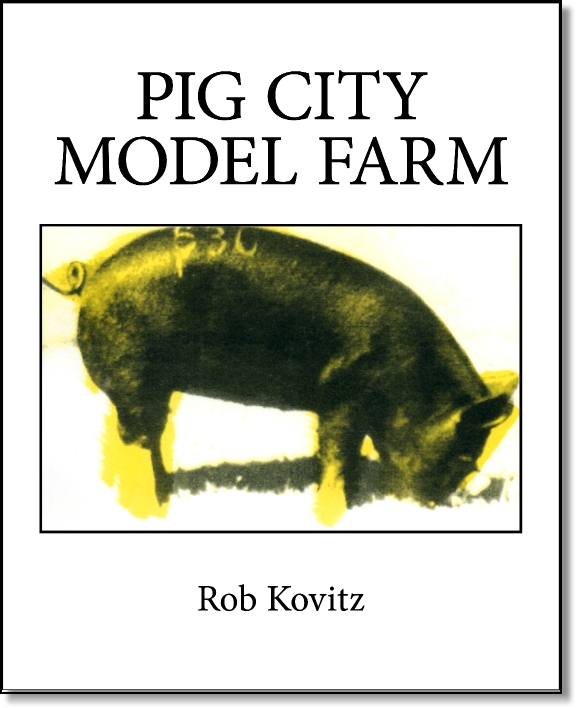review
Review by Ken Hayes
The Splinter #5, Fall 1992, p. 21.
I read recently (and I don't remember where) that the only reference Martin Heiddegger ever made to the Holocaust was an analogy to protest the industrialization of farming. Though he never mentions this, Rob Kovitz's recently published book Pig City Model Farm seems not least as if it-were a response to this all-but complete silence compounded by a flagrant moral inversion. However, Kovitz warily reserves an easy condemnation (the intent of the forgotten author of my citation) for an ultimately more daunting expression of outrage. Pig City Model Farm is a homely, manipulative book, full of hooks, and it refuses to be ignored. On the book mark included in each copy, Kovitz quotes Bernard Tschumi saying " Needless to say, all books are most pleasurable when they question academic and popular assumptions/when they disturb acquired tastes and fond architectural memories." But Pig City goes so much further in dredging up slops, at which Kovitz has a real talent, that his work shows up Tschumi’s blithe posturing.
The title indicates the book's premise. By criss-crossing the discourses of pig farms and model cities, Kovitz means to reveal the forces of cultural preservation that are intent on keeping them carefully separate and in their places. In this he joins in on making a challenging definition of architecture, just now emerging: architecture as the techniques of producing and ensuring differences and the concomitant capacity to evaluate; as all those means we have of establishing, recognizing and respecting hierarchy; simply, what makes obvious the difference between the model city and the pig farm. This requires the termination of the historical dominance of humanism, which he tries by taking seriously and acting on the analogy he quotes: "The anatomy of the pig approximates that of man almost more closely than any other animal."
To these visceral ends, Kovitz applies means, such as citation and sub-textual reading, that are increasingly often employed at present but seldom so fully-realized as in this book. Yet it is indicative of the relative amenability of writing and making architectural propositions to his aims that Kovitz makes recourse to the archaic form of the book. What results is more like an artist's book-work of the nineteen-seventies than any current architectural publication. Pig City also calls to mind that characteristically nineteenth century type of rural publication, the farmer’s compendium, almanac or agricultural miscellany, though less clearly than did the format of the first self-published edition.
The book is composed entirely of a sequence of quotations from what seem initially like heteroclite sources; farming manuals and government publications, the writings of the Utopian Fourier and comments on him by Roland Barthes, literature of the 1960’s, and certain strains of contemporary architectural thought. Yet rather than being disjointed, it has an exemplary clarity that acts on our assumptions about reading, writing and making sense.
Like many artist's books it also invokes personal experience. The effacement of the author is conversely manifest in the vertiginous elaboration of the conventions of the book, now evacuated then refilled. Thus Pig City is replete with parts: dedication, preface, Author's note, (no table of contents), postscripts, acknowledgments, appendices: all quoted with a punctiliousness that becomes exasperating and that alerts one that this is not a book so much as it is a "book", the difference denoted by the hyphenation book-work.
Pig City has some uncanny similarities to Sue Coe's also well researched graphic book Porkopolis, but their differences are instructive. Coe still finds energy in the expressionist, activist, polemical graphics of John Heartfield and Dada, and her invective is messy, overt,, engaged and intent on rescuing herself. Kovitz, on the other hand, exercises a hyper-prosaic, 'New Objectivity'-like restraint, to more extreme ends, as if expression had become woefully inadequate, a mere set of stylistic effects. Ludwig Hilberseimer comes to mind, and he is of course quoted. The dubious logic of aversion therapy comes into play. The rigid order of a Master Plan linking all parts mocks the results of an opinion poll Kovitz conducted about how the book should be best ordered and that favoured randomness. He was likely right in avoiding this, for despite the semblance of collage, the book has the highly particular order of 'one thing following another' that characterized minimalism . If this is protest, as it no doubt is, it is of a type that eschews all exuberance for a rigid implacability, but that nevertheless fuels a virtuosity of manipulation intent on confounding all elevating sentiments, including the love of order.
No matter how wary Kovitz has been, his tight-rope act risks replicating the managerial other-worldliness we recognize is a legacy and consequence of Utopian thought. He knows the problem of Utopian discourse is the violence and inhumanity of its incommensurability with the world as it is. Utopia is like some uncanny foe that when punched, sticks, and every effort to disentangle only tangles one further. When Plato was asked how his republic would be realized he indicated that all the adults of an existing city would be lead into the country-side and the remaining children strictly trained – euphemism for procedures all-too recognizable after our century of camps and pogroms, cultural revolution, communist trials, class war and repressive intoxication and infection. Pig City Model Farm eggs us into seeing this.
treyf books
keep refrigerated
![]()
